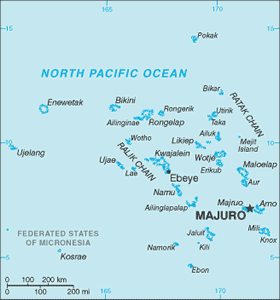The Geography of Marshall Islands
The Geography of Marshall Islands
Marshallese Geography
Location: Oceania, two archipelagic island chains of 29 atolls, each made up of many small islets, and five single islands in the North Pacific Ocean, about half way between Hawaii and Australia
Geographic coordinates: 9 00 N, 168 00 E
Map references: Oceania
Area: total: 181.3 sq km land: 181.3 sq km water: 0 sq km note: the archipelago includes 11,673 sq km of lagoon waters and includes the atolls of Bikini, Enewetak, Kwajalein, Majuro, Rongelap, and Utirik
Area - comparative: about the size of Washington, DC
Land boundaries: 0 km
Coastline: 370.4 km
Maritime claims: territorial sea: 12 nm contiguous zone: 24 nm exclusive economic zone: 200 nm
Climate: tropical; hot and humid; wet season May to November; islands border typhoon belt
Terrain: low coral limestone and sand islands
Elevation extremes: lowest point: Pacific Ocean 0 m highest point: unnamed location on Likiep 10 m
Natural resources: coconut products, marine products, deep seabed minerals
Land use: arable land: 11.11% permanent crops: 44.44% other: 44.45% (2005)
Irrigated land: 0 sq km
Natural hazards: infrequent typhoons
Environment - current issues: inadequate supplies of potable water; pollution of Majuro lagoon from household waste and discharges from fishing vessels
Environment - international agreements: party to: Biodiversity, Climate Change, Climate Change-Kyoto Protocol, Desertification, Hazardous Wastes, Law of the Sea, Ozone Layer Protection, Ship Pollution, Wetlands, Whaling signed, but not ratified: none of the selected agreements
Geography - note: the islands of Bikini and Enewetak are former US nuclear test sites; Kwajalein atoll, famous as a World War II battleground, surrounds the world's largest lagoon and is used as a US missile test range; the island city of Ebeye is the second largest settlement in the Marshall Islands, after the capital of Majuro, and one of the most densely populated locations in the Pacific


